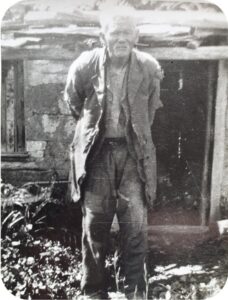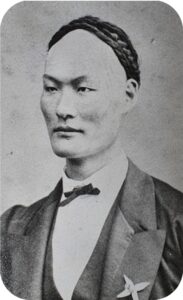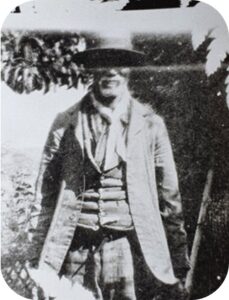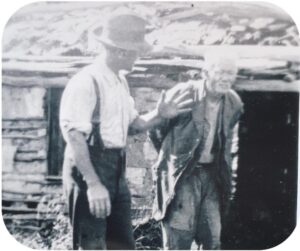The Bush Cemetery- Ah Hung’s Grave – Last of the Turon Chinese
Robert G. V. Baker
Bush cemeteries are quintiessential repositries of Australian history that often have been forgotten and overrun with the progress of time. Wattle Flat has such a cemetery located a kilometre along the Limekilns Road from its junction with the Sofala Road. It was dedicated in 1884 (Figure 1A) to plan for a growing population from a hoped expansion of reef mining in the district.

Figure 1A 1884 Plan for the General Cemetery; B The Wattle Flat ‘Bush Cemetery’
In the 1891 census, there were 613 Europeans and 11 Chinese listed with 342 males in the Wattle Flat District. This was boosted in the 1890s, when the Big Oakey Gold mine, producing 1600 ounces of gold between 1895-1896, which also attracted investment and employment into the district. This rich patch disappeared suddenly with complex faulting in the ground rock and, by the early 1900s, the population had dwindled to 204 adults in the 1901 Census. For example, Charles Vassella moved in 1900 from Wattle Flat to Newnes with his family to gain jobs in the burgening oil shale mining, commencing operations in the Wolgan Valley. By WW1 reef mining had all but finished, where younger families moved away whilst the older miners and identities stayed as outliers from a bygone era.The population and service decline was substantial. In a letter dated 1/9/1921 to her nephew James Vassella at Lithgow, Isabella Mini (whose husband was a co-owner of the Big Oakey Gold Mine) reported:
“…have had three weddings on the old flat, Henry Kneale and a girl from Bathurst; Bill Bright and Sara McKinney and Elva Watts- quite a grand affair, so things ought too soon brighten up in the old place once more. Me and uncle (John Mini) are very quiet here and your uncles Jim and Jock (Mitchell – old miners whose family came to Wattle Flat in 1854) are just the same old style- don’t think one could shift them at any price. And Sofala is going down too. Taylors are leaving this week for Kandos so now we will have to get goods from Bathurst. Joe McKinney (Wattle Flat) is closing up his shop so that speaks bad don’t you think.”


Figure 2 Letter from Isabel Mini to her nephew James Vassella, Lithgow.
This context of decline provides a background to the use of cemetery.
The dates of burial occur during a period ranging from 1910 to 1925 on the headstones and are in the Church of England section. There are six remaining monuments, four with legible memorials (Figure 1B), namely:
Louisa Mann, died 1924, aged 87 years,
Arthur George Eldridge, died 1912, aged 47 years,
John Hart Dean, died 1925, aged 84 years,
Alexander Forster, died 1910, aged 21 years.
(Source: Barbara J. Hickson 2008)
Further inland, there is another cement gravestone of the style found in other Wattle Flat cemeteries (Figure 3), where the inscriptions were black paint, dating from 1900-1910, now weathered over time.

Figure 3 Grave in the Centre of the Cemetery (Source: Barbara J. Hickson 2008).
It appears that after 1925, the cemetery fell into disuse with the eucalypts invading, surrounding the remaining grave stones. It is within this context that another grave was identified in this cemetery by Bill Pittendrigh accompanied by myself in 1975: the grave of Charles Ah Hung- The Last of the Turon Chinese.

Figure 4 Charlie Ah Hung, Gellard’s Hut, Wattle Flat 1920s.

Figure 5 Young Chinese Miner 1870s.

Figure 6 Charlie Ah Hung in his garden c1910.

Figure 7 Bill Pittendrigh talking to Charlie Ah
Hung, Gellard’s Hut, 1920s.
Charles Ah Hung was the last of a generation. In 1861, the Turon Goldfield had the highest proportion of Chinese (42%) in a goldfield population in NSW. By the early 1920s, he was the last Chinese resident at Wattle Flat. At the start of 20th century, the remaining Chinese had either left or died, with a ritual of sending their bones back to China.
Belle Vassella (Robson) remembered that on a Maloney’s Coach trip from Wattle Flat to Bathurst in 1915, a kindly old Chinaman gave her young sons biscuits from a jar to hearten them on. Ah Hung’s last residence was at Gellard’s Hut, near the Wattle Flat Recreation Ground.
Ted Reilly remembered him as an old identity, where, on Ah Hung’s trips to town, passing the school fence, the kids would rush up and ask him “When is it going to rain?” He would always answer: “Tomorra”.
On his death in 1925, the Wattle Flat policeman found 25 sovereigns concealed under his bed and later, 80 more gold sovereigns and half sovereigns buried in a tin in his garden. This golden hoard gave a false impression: Ah Hung had no other means of support. The Chinese were not eligible for the Old Age Pension Act which in 1908-09 stipulated that no Asiatics were eligible in any circumstances, even if they were naturalised. Bill Pittendrigh remembered building a quick coffin out of fruit boxes and on a sulky, escorted by Charles Jones JP, transported his body to this spot for burial as the Last of the Turon Chinese.

Figure 8 a tea spout; b incense burner; c coins found along Limekilns Rd, Wattle Flat; d lucky gambling cup; e opium pipe
References and Further Reading
Baker R. G. V. Historic Sofala, CentrePak Research, Cronulla 1986
Hickson B. J. Conservation Management Plan for Wattle Flat General Cemetery, Barbara J. Hickson in association with Bathurst Regional Council 2008
Kwok J. The Chinese in Bathurst: Recovering Forgotten Histories, Charles Sturt University, Bathurst 2018.
https://researchoutput.csu.edu.au/ws/portalfiles/portal/71942432/Juanita_Kwok_Thesis.pdf
Higgins M. Gold and Water: A History of the Sofala and Wattle Flat Goldfield, Robstar Publications, Bathurst 1990.


